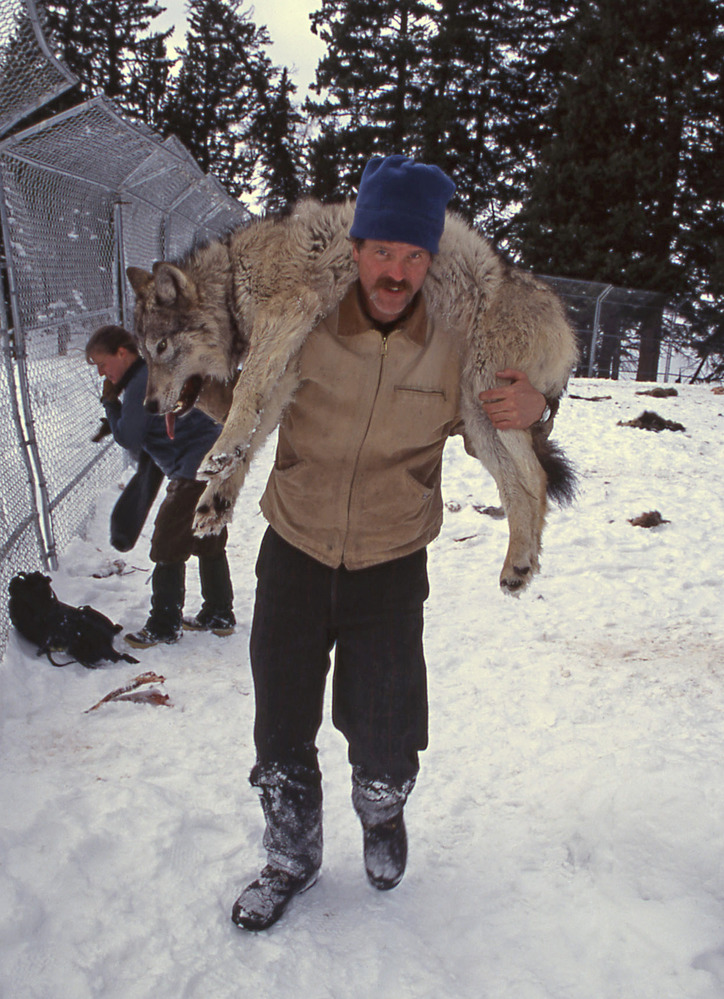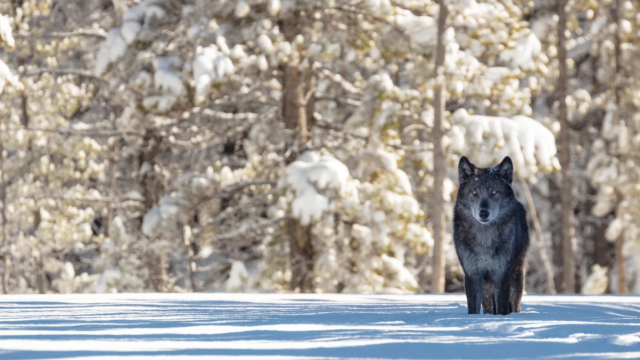Twenty-five years ago, wildlife managers in Yellowstone National Park undertook one of the most consequential actions in modern American conservation when they unleashed 14 wolves into the park.
The program to reintroduce wolves to Yellowstone in 1995 has since seen wolf packs fan out across one of the largest intact ecosystems in the Lower 48. Reintroducing an apex predator that humans wiped out earlier in the century has had consequences both intended and unintended. It was ” and continues to be ” wildly controversial but also 100% right. Ecosystems have flourished under a newly found balance; tourists have come to catch a glimpse of animals no longer found in many other states; and scientists have had a chance to observe an unprecedented experiment in rewilding.
“We’ve learned from them,” said Yellowstone National Park biologist Doug Smith. “All of nature is worthy of our care and attention, and wolves are the flagship species that a human dominated world almost did in. Respecting them and allowing them to exist is very important for us as well as for them. “
Wolves are one of the most adaptable creatures on Earth. Their range once included all of Europe, the majority of North America and Asia, and even parts of the Middle East. They can make do in some of the hottest, coldest, wettest, and driest places on Earth. Their ability to find a niche and fill it often puts them in a role keystone species; their presence (or absence) dictates the fate of other animals and even plants in many places around the globe.
Despite that ” or perhaps because of it ” humans have not been kind to wolves. In the western world, we’ve been conditioned to fear them since childhood through fairy tales from Little Red Riding Hood to the Three Little Pigs. They’ve been shot, poisoned, and forced from their traditional range, which humanity has then, in many cases, turned over to crops or livestock.
Yellowstone stands as a somewhat odd case. The park was set aside in 1872 and came under the National Park Service when the agency was created in 1916 to (emphasis added) “conserve the scenery and the natural and historic objects and the wild life therein and to provide for the enjoyment of the same in such manner and by such means as will leave them unimpaired for the enjoyment of future generations.” Except, it seems, for the wolves. The U.S. government’s war against the toothsome canines raged inside the park’s border until they were essentially wiped out in 1926.
That allowed elk populations to explode and ranchers to take over land outside the park without concern of the occasional wolf predation on their cattle. And it threw the entire ecosystem out of whack. Elk over-browsed certain plants like willows as populations boomed and they no longer had to fear wolf packs. That led to impacts on songbird and beaver habitats.
In effort to right the wrong, scientists hatched a plan to reintroduce wolves. It took years to build the plan and garner support for it. Mark Boyce, an ecologist at the University of Alberta, has been studying the elk in the area in the 1970s. The park approached him in the mid-1980s to model what could happen to the herds that roamed the area if wolves were reintroduced.
“My initial reaction was just a cold, flat “˜no way,’” he said. “I knew it was a hot potato, and no matter what I did, there were going to be a lot of people who disagreed with it.”
Boyce eventually relented, though, when the federal government offered enough money to make the headaches worth it. His model showed the elk population would drop by anywhere from 10% to 30% but that sport hunting would still be “compatible with wolf recovery.” That undercut the idea that wolves would outcompete human hunters for elk, one of the main arguments from those opposed to wolf reintroduction. Boyce also programmed a user-friendly version of his model and sent out a bunch of floppy disks to schools and universities as an educational (and, perhaps, PR) tool. Sadly, he didn’t still have a copy to send Gizmodo.
On the strength of Boyce’s modelling and other work, the first of multiple shipments of wild wolves were brought to the park in 1995 from Alberta. The first groups were released in March 1995, and another group was brought in and left to roam in 1996. After that, though, the success of the early packs put an end to the reintroduction phase that was supposed to last five years.
So began an experiment that will last, hopefully, as long as we do. The access the park affords for researchers to watch wolves while simultaneously allowing the animals to prowl 2.2 million largely uninterrupted acres is a unique combination found nowhere else on the planet. Federally funded scientists with a mandate to keep tabs on the park also provide a unique temporal aspect to the research.

“Eighty per cent of wildlife studies are three to five years,” Smith said. “Literally, that’s just scratching the surface, because you might be just getting one phase of a cycle or the animals may be doing something different because of some unique circumstance. You just capture that moment in time. You’ve got to go through the ups and downs, the hard winters, the easy winters, the droughts, the human disturbance that shoots up a pack. You’ve got to get that whole menu of possibilities. It gives you great insight. I think the 25-year thing is just a start.”
So what have scientists learned in 25 years? True to their keystones species role in the Greater Yellowstone Ecosystem, the wolves created what ecologist call a trophic cascade. Basically, once they resumed their role as a dominant predator, the effects rippled through the ecosystem. Wolves knocked down the elk population, willows sprung back, and beavers benefitted, which resulted in more beaver ponds that in turn created habitat for other aquatic animals.
Boyce’s model did great through the first 10 years. It stochastic processes ” basically, random nudges ” in its guts kept it true. But chaos in the real world eventually outpaced the model, since there’s no way to account for every variable. The elk population continued to dip, going from 19,000 head prior to wolf reintroduction to a nadir of 4,000 in 2012. The population now appears to be stabilizing at around 8,000 elk, slightly lower than Boyce’s initial modelling predicted but still healthy. A 2018 paper from Boyce attributes some of the bigger-than-predicted decline to grizzly bears and cougars killing more elk than expected. Bison ” usually too fearsome a creature for wolves to hunt ” have also moved into some of the spaces vacated by elk, likely furthering the decline in elk numbers.
But population dynamics was only one of the surprises. Smith said being able to observe the social bonds between wolf packs and individuals in such detail is all but unprecedented and still a very active area of research. He pointed to the impact of wolf hunting, which is not allowed in the park but is on the lands that surround it.
“[The thought was] you can kill them at a high rate, and they’ll deal with it,” he said. “They do, but that’s from a population standpoint. That’s not from a social standpoint. They’re very, very social. If you kill the wrong wolf, it can be very destabilizing to the family group.”
Then there’s the human side. Signs that wolves are adversely impacting elk hunters is murky as wildlife management agencies adjust the number of permits they issue from year to year. In Wyoming, for example, the state cut the number of elk permits only to see the population balloon in 2018 that in turn led the agency to extend the hunting season for elk.
But tourism dollars from wolf watchers have brought in millions. An wildlife guide in Jackson, Wyoming around the time the study came out, I can attest to the fact that people came to try and catch a glimpse of the wolves. In summer, the Lamar Valley of Yellowstone ” which a former park ranger colleague of mine referred to as “basically a National Geographic documentary” ” is packed with tourists with binoculars and spotting scopes looking for signs of resident wolf packs loping along the valley floor or high in the mountains.
All that said, it’s frankly a little gauche to put a dollar sign on nature restored. Sure, it might help make the case to Congress or local business owners or ranchers who are compensated when wolves kill their cattle. But it denigrates the real value of what’s happening in the Lamar Valley and across the Greater Yellowstone Ecosystem that stretches beyond the park’s boundaries.
Balance has returned, and if we pay attention, it can teach us a valuable lesson about not just how to live with wolves but how to rethink the way we live with the natural world.
“We’re heading toward a new equilibrium,” Boyce said. “We’re learning how to coexist with large carnivores. Maybe I’m an eternal optimist.”
Smith said the wolves could end up helping us manage the single biggest human assault on nature in the form of the climate crisis. As they prepare to study wolves for the next 25 years, Smith and other researchers are keen see how the predators will manage prey in a warming world. In the Yellowstone area, weather is projected to become more unstable. Because wolves are adaptable, Smith said it’s quite possible they’ll be able to ride out the milder winters mixed with the occasional cold blast and essentially act as a “buffer” on elk population so it never booms or busts but stays just right against the shifting baseline.
In this corner of the world, at least, it may just be that nature saves itself from our worst decision to pollute the atmosphere. We could learn a lot from that.
